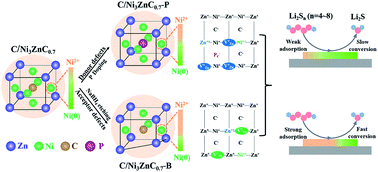Rational valence modulation of bimetallic carbide assisted by defect engineering to enhance polysulfide conversion for lithium–sulfur batteries†
Abstract
The reasonable design of metal compound electrocatalysts is proved to be a good approach to accelerate the sluggish conversion kinetics of polysulfides for high performance lithium–sulfur (Li–S) batteries. Since metal cations usually serve as the active sites to interact with polysulfides, optimizing their electronic and valence states is vital to enhance catalytic activity, especially for electrochemical reactions involving multiple electrons. Herein, the electronic and valence states of metal active sites in hollow carbon-encapsulated Ni3ZnC0.7 (denoted as C/Ni3ZnC0.7) nanospheres are modulated by introducing either donor defects (P dopants) or acceptor defects (Ni vacancies) via P-doping or NaBH4-etching, respectively. Such P dopants and Ni vacancies not only endow P-doped C/Ni3ZnC0.7 (denoted as C/Ni3ZnC0.7-Pm) and NaBH4-etched C/Ni3ZnC0.7 (denoted as C/Ni3ZnC0.7-Bn) nanospheres with abundant defects and distortions, but also modulate the valence states of metal active sites in different ways. P dopants and accompanied Zn vacancies remarkably decrease the electron density of Zn active sites in C/Ni3ZnC0.7-P5 while the Ni vacancies contribute to the dramatic increase of Ni2+ species in C/Ni3ZnC0.7-B1 nanospheres. The modulated Zn sites could anchor polysulfides and serve as reservoirs to regulate the valence of Ni sites. However, the modulated Ni active sites with more Ni2+ species enable fast electron transfer between the Ni2+/Ni(0) pair and polysulfides, playing a more significant role in catalyzing the conversion of polysulfides. As a result, compared with C/Ni3ZnC0.7 and C/Ni3ZnC0.7-P5, C/Ni3ZnC0.7-B1 with more Ni2+ species exhibits stronger chemical adsorption ability toward polysulfides and catalytic ability to accelerate the conversion kinetics of polysulfides. When C/Ni3ZnC0.7-B1 nanospheres are used to modify commonly used PP separators for Li–S batteries, remarkable rate performance up to 4.0C (525.6 mA h g−1) and excellent cycling stability (a decay of 0.0179% over 1400 cycles at 1.0C) are achieved.



 Please wait while we load your content...
Please wait while we load your content...